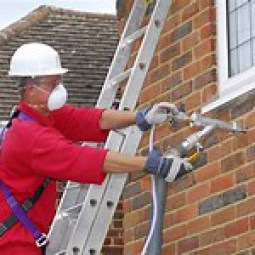Cavity Wall Insulation
Most of the original Burlingham houses on Abbotswood have external cavity brick walls. However there are a number of instances where original properties (for instance at houses 2, 39 and 40) have some areas of external walls that are in solid construction. Those houses with tile hanging at first floor level are also likely to have either solid wall or even timber framed construction behind the tiles. Where solid walls or timber framed construction occur alternative means of thermal insulation will need to be considered.
Cavity walls can be insulated retrospectively by injecting insulation material into the cavity from the outside. A specialist company will drill holes in the outside walls, inject insulation through the holes and then seal them with cement. The insulation material is usually glass fibres, polystyrene beads or polyurethane foam. Of these three materials, polyurethane foam has the best insulation value with a Lambda value of 0.030 W/MK. The fluid material is injected into the cavity after which it expands and fills all the cavities.
There have been some highly publicised problems with retrospective cavity wall insulation which have tended to make people wary about having their walls filled. On the whole the majority of homes with cavity walls should be suitable. However there are certain situations, usually on very exposed sites, when a home is not so it is best to seek professional advice.
One important consideration with the original houses on Abbotswood is that they typically have suspended timber ground floors where the cavity beneath the floor must be kept ventilated. Ventilation is achieved by airbricks in both the inner and outer skins of external walls often located close to the ground. It is paramount that these airbricks are sleeved and isolated from the cavities before anything is injected into the wall cavities. Generally it is also important to ensure that any airbricks which serve either cooker extractors or bathroom and cloakroom extractors are similarly sleeved and isolated from the cavities otherwise they will be rendered inoperable. They usually are sleeved - but it is worth checking.
Please bear in mind that saving energy and insulating property is a hot topic at the moment. Sadly rogue traders are capitalising in this and offering cavity wall insulation services. The actual scam can vary, but often a bogus trader will claim to be part of an energy-saving scheme offering discounted rates, they may state that the home-owner can claim back the cost of the work under an energy conservation scheme, or they sometimes over exaggerate the potential reduction in heating bills. In any case, high prices will often be charged for shoddy or non-existent work. For further advice please refer to section on Rogue Traders.
As a general rule, and at prices in 2023, the cost of injecting insulation material into existing cavity walls should cost between £13 and £26 per square metre. Glass fibre is the cheapest at £13/m2 and polyurethane foam the most expensive at £26/m2. So you should allow roughly between £2500 and £4000 for a typical detatched house excluding the cost of sleeving airbricks. Obviously the actual cost will depend on the size of the property.
Finally it is worth bearing in mind that insulating your property not only keeps it warm in the winter but also keeps it cooler in the summer - something that will become of particular significance in years to come.


